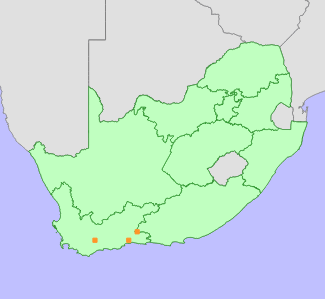|
Scientific Name | Erica elsieana (E.G.H.Oliv.) E.G.H.Oliv. |
Higher Classification | Dicotyledons |
Family | ERICACEAE |
Synonyms | Philippia elsieana E.G.H.Oliv. |
National Status |
Status and Criteria | Endangered D |
Assessment Date | 2012/08/24 |
Assessor(s) | R.C. Turner, J.H. Vlok, A.L. Schutte-Vlok & L. von Staden |
Justification | A wide-ranging (EOO 4435 km²), but highly localized habitat specialist (AOO <1 km²), known from three very small subpopulations, and with total population size estimated to be fewer than 250 mature individuals, but not suspected to be declining. |
Distribution |
Endemism | South African endemic |
Provincial distribution | Western Cape |
Range | Langeberg, Outeniqua and Groot Swartberg mountains between Swellendam and Oudtshoorn. |
Habitat and Ecology |
Major system | Terrestrial |
Major habitats | South Swartberg Sandstone Fynbos, South Outeniqua Sandstone Fynbos, South Langeberg Sandstone Fynbos |
Description | Moist, sheltered rock ledges on mountain summits above 1400 m. |
Threats |
| This species' high altitude habitat is well protected and it has no known threats. It is a slow-growing reseeder and may possibly be threatened by too frequent or intense fires, however, its sheltered habitat offers protection against fires. |
Population |
Erica elsieana is known from three widely disjunct peaks in three mountain ranges in the southern Cape. It is a highly localized habitat specialist, and observations at two of the three known subpopulations indicate that subpopulations are very small, with 30-50 plants recorded on the Saagtandberg (Outeniqua Mountains), and about 30 plants on the Kolberg (eastern Groot Swartberg). There are relatively few other peaks of sufficient altitude within the Langeberg and Outeniqua mountains, but these, such as the Grootberg Peak in the Boosmansbos Wilderness Area, Paardeberg Peak east of Garcia's Pass and Engelseberg above Robinson Pass have been well explored and this species has not yet been recorded there. It is therefore estimated that the population consists of fewer than 250 mature individuals. This species' habitat is well protected and it is not suspected to be declining.
|
Population trend | Stable |
Assessment History |
Taxon assessed |
Status and Criteria |
Citation/Red List version | | Erica elsieana (E.G.H.Oliv.) E.G.H.Oliv. | EN D | Raimondo et al. (2009) | |
Bibliography |
Goldblatt, P. and Manning, J.C. 2000. Cape Plants: A conspectus of the Cape Flora of South Africa. Strelitzia 9. National Botanical Institute, Cape Town.
Oliver, E.G.H. 1984. Studies in the Ericoideae. IV. New species and some taxonomic and nomenclatural changes in the Cape Flora Region. South African Journal of Botany 3:267-284.
Oliver, E.G.H. 1987. Studies in the Ericoideae. VII. The placing of the genus Philippia into synonomy under Erica; the southern African species. South African Journal of Botany 53:455-458.
Raimondo, D., von Staden, L., Foden, W., Victor, J.E., Helme, N.A., Turner, R.C., Kamundi, D.A. and Manyama, P.A. 2009. Red List of South African Plants. Strelitzia 25. South African National Biodiversity Institute, Pretoria.
|
Citation |
| Turner, R.C., Vlok, J.H., Schutte-Vlok, A.L. & von Staden, L. 2012. Erica elsieana (E.G.H.Oliv.) E.G.H.Oliv. National Assessment: Red List of South African Plants version 2024.1. Accessed on 2025/12/13 |
 Comment on this assessment
Comment on this assessment


